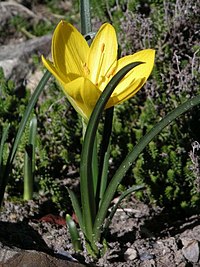Sternbergia
| Sternbergia subsp. var. | Autumn crocus, Autumn daffodil | |||||||||||||||||||||||||||||||||||||||||||||||||||||||
|---|---|---|---|---|---|---|---|---|---|---|---|---|---|---|---|---|---|---|---|---|---|---|---|---|---|---|---|---|---|---|---|---|---|---|---|---|---|---|---|---|---|---|---|---|---|---|---|---|---|---|---|---|---|---|---|---|

|
|
| ||||||||||||||||||||||||||||||||||||||||||||||||||||||
| ||||||||||||||||||||||||||||||||||||||||||||||||||||||||
Sternbergia is a genus in Amaryllidaceae of around 8 species that show a broad distribution throughout Mediterranean Europe and Asia, and was first described by Clusius in 1601 as Narcissus, before being redescribed by Carl Linnaeus as Amaryllis in 1753. The plant referred to by both these descriptions is now recognised as being Sternbergia lutea, which was described by Franz von Waldstein and Pál Kitaibel in 1803, although their first validation of the name Sternbergia was applied to S. colchiciflora.
This genus contains a number of species of flowering bulbs which rather resemble the Crocus. These plants produce golden-yellow goblet-shaped flowers borne on stalks some way above the ground that open during the autumn or early winter. The flower is composed of six stamens and a single style attached to an inferior ovary. Long, strap-like leaves may appear with the flowers or sometime after. The only two exceptions to this are S. vernalis and S. candida which flower in the spring, with S. candida producing striking white flowers.
The genus has gained notability due to the wide-spread use of S. lutea as a garden plant, and it has been found in cultivation for several hundred years, and the species has become naturalised in many parts of northern Europe, greatly extending the natural range of the species.
| Standard Cyclopedia of Horticulture |
|---|
|
Sternbergia (named for Count Caspar Sternberg, a botanist and writer, 1761-1838). Amaryllidaceae. Low-growing bulbous herbs, hardy and used for outdoor planting. Leaves produced after or with the fl., strap-shaped or linear: scape short: fls. frequently solitary, rarely 2, bright yellow; perianth funnel-shaped, erect, tube short or rather long, lobes linear or lanceolate, erect-spreading; filaments filiform, free; ovary 3-celled: fr. fleshy, ovoid or oblong, scarcely dehiscent; seeds subglobose.— About a dozen species, E. Eu. to Asia Minor. The bulbs should be planted rather deeply, about 6 in. J. N. Gerard says of their culture that they require a rather heavy soil, in a somewhat dry sunny position where they will be well ripened in summer. CH
|
Cultivation
Propagation
Pests and diseases
Species
Sternbergia lutea
Sternbergia sicula
Sternbergia candida
Sternbergia vernalis
Sternbergia clusiana
Sternbergia colchiciflora
Sternbergia schubertii
Sternbergia pulchella
Sternbergia greuteriana
Sternbergia minoica
Gallery
References
External links
- w:Sternbergia. Some of the material on this page may be from Wikipedia, under the Creative Commons license.
- Sternbergia QR Code (Size 50, 100, 200, 500)
